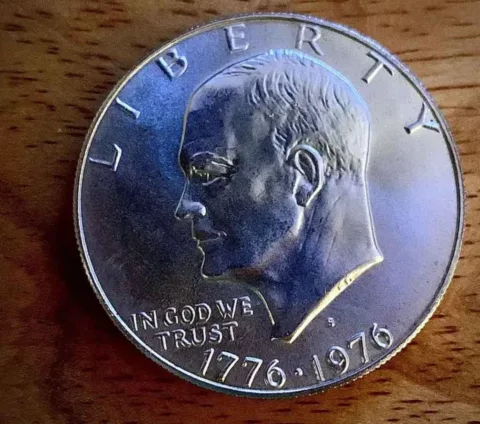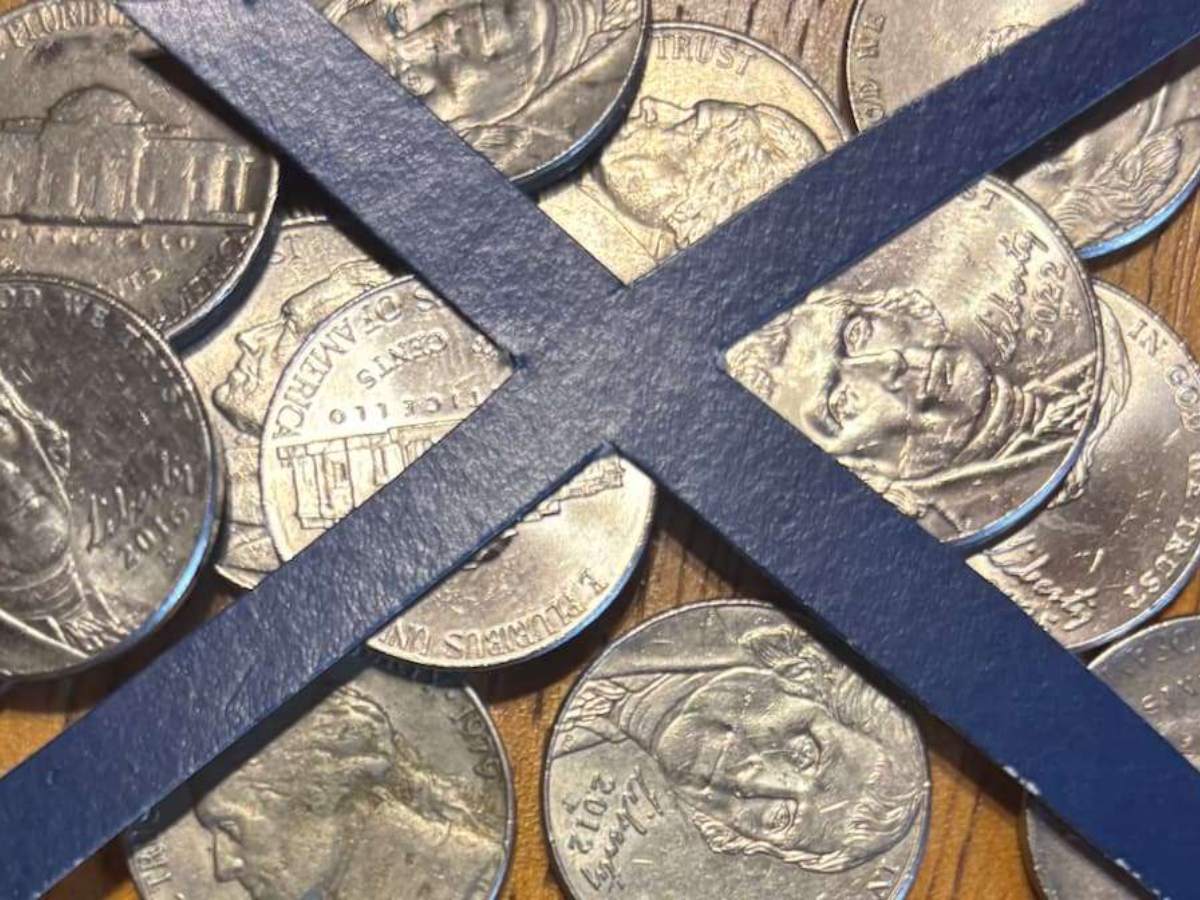
If you have any 1976 Eisenhower dollar coins, you’ll want to double check their value!
Some 1776-1976 silver dollars are worth nearly $30,000!
So, what makes a 1976 dollar coin worth thousands of dollars?
And… are 1976 Bicentennial dollars worth nearly as much?
1976 Silver Dollar Facts
Before we get into 1976 silver dollar values, I want to point out that most 1976 Eisenhower dollars aren’t really made from any silver at all.
Unless your 1976 Ike dollar has a little “S” mintmark on it (below Eisenhower’s portrait and above the date), it’s not made from silver but rather copper-nickel clad.
Only a small number of 1776-1976 Bicentennial coins were made in silver, and these were sold to coin collectors.
Virtually all of the 1976 dollar coins in circulation or floating around elsewhere are made from copper-nickel clad — not silver.
IMPORTANT: What Is The Grade Of Your 1976 Dollar Coin?
To determine the true value of your 1976 dollar coin, you first need to know what condition (or grade) your coin is in.
Grab a coin magnifier and a copy of the U.S. Coin Grading Standards book. Then, watch this video to see how to grade coins yourself at home:
These are the best coin grading apps that will make grading coins yourself much easier.
1976 Type I vs. Type II Clad Dollar Coins
What is a Type I Bicentennial dollar — and how does it compare to a Type II Bicentennial dollar coin?
Let’s explore the differences…
Notice how the inscriptions on the tails side (reverse) of this 1976 Bicentennial dollar coin have a blocky appearance?


1976 Type I Clad Dollar Coin Value
The Type I dollars were struck in 1975 — the year the Bicentennial design by 22-year-old Dennis R. Williams went into production upon its pairing with the head’s side (obverse) Eisenhower portrait by Frank Gasparro.
A total of 4,019,000 Type I clad dollars were made the Philadelphia Mint, and they have no mintmark.
They’re worth around $2 in circulated condition and $12 to $20 in uncirculated grade.
Amazingly, the all-time record price for the most valuable 1976 Type I clad Bicentennial dollar coin goes to a most unlikely error, in which a 1976 quarter was struck with the 1976 Bicentennial dollar design. This fascinating 1976 dollar coin error was graded MS64 by Numismatic Guaranty Corporation and sold in 2014 for a whopping $28,200!
1976 Type II Clad Dollar Coin Value
As you can see by looking at the photos above, the Type II dollar coin has the crisper, more refined lettering on the tail’s side of the coin.
Chances are you’ve got a Type II dollar — because they are generally much more common than the Type I dollar coins.
Compare the mintage of 113,318,000 for the 1976 Type II dollar coin from the Philadelphia Mint (whose Eisenhower dollars carry no mintmark) with the scant output of barely more than 4 million for the Type I dollar coin.
The 1976 Type II clad dollar coin trades for around $1 in worn grades and $4 to $10 in typical uncirculated condition.
As with the 1976 Type I clad dollar, another error takes the cake as the most valuable specimen of the 1976 Type II clad dollar coin ever sold. In this case, the price tag was $8,050 for an error involving the 1976 Type II clad dollar design struck on a dime. It was graded MS64 by Numismatic Guaranty Corporation and sold in 2007.
1976-D Type I Clad Dollar Coin Value
The 1976-D Type I dollar coin from the Denver Mint sports a “D” mintmark under the head of Eisenhower and above the date.
The Denver Type I dollar coin has the identical reverse design to the Philly version and carries the blockier letter styling. A total of 21,048,710 of these coins were struck.
The 1976-D Type I clad Bicentennial dollar fetches about $1.50 in circulated condition and $5 to $10 in uncirculated grades.
The record price for a 1976-D Type I Eisenhower dollar is $9,600. That’s the amount paid in 2020 for a specimen graded MS67 by Professional Coin Grading Service.
1976-D Type II Clad Dollar Coin Value
The 1976-D Type II dollar coin saw nearly 4 times the mintage of its sans-serif counterpart and was struck to the tune of 82,179,564 pieces.
The “D” mintmark on the obverse signifies this as a Denver-minted issue.
As with the Philly Type II dollar coin, look for the refined lettering with feet (or serifs) on the reverse.
Worn specimens are worth around $1, while uncirculated pieces take $4 to $10.
One of the priciest examples of a 1976-D Type II clad dollar coin was graded MS67 by Numismatic Guaranty Corporation and sold for $3,600 in 2021.
1976-S Type I Clad Proof Dollar Coin Value
The United States Mint struck a variety of 1976 Bicentennial dollars at the San Francisco Mint — for collectors who wanted special proof versions of this popular coin.
Among these were several proof specimens made with polished blanks and struck twice on high-tonnage presses with specially prepared dies. These collector strikes have an “S” mintmark, indicating the origin of these coins was the San Francisco Mint.
The San Francisco Mint struck 2,845,450 examples of the 1976 Type I Bicentennial dollar coins. They were included in the 6-piece 1975 proof sets, which also include a clad 1776-1976 Bicentennial quarter, clad 1776-1976 Bicentennial half dollar, and a 1975 penny, nickel, and dime — all in proof.
A typical 1976-S Type I clad dollar coin in proof is worth $10 to $15.
The all-time record price for a 1976-S Type I clad proof dollar coin goes to a PR70DCAM specimen graded by Professional Coin Grading Service — which sold in 2011 for $25,300.
1976-S Type II Clad Proof Dollar Coin Value
The 1976-S Type II clad proof dollar was included in 6-piece 1976 proof sets that also include the 1976-dated penny, nickel, and dime as well as the 1776-1976 Bicentennial quarter and 1776-1976 Bicentennial half dollar — all bearing “S” mintmarks.
A total of 4,149,730 were struck and they’re now worth $8 to $12 apiece.
The all-time record price for the 1976-S Type II clad proof dollar coin was achieved in 2014 when a specimen graded PR70DCAM by Professional Coin Grading Service sold for $22,550.
1976-S Silver Uncirculated Dollar Coin Value

So, what about those 1976 silver dollars? (The ones that are really silver.)
These were struck with a 40% silver composition and made only for collectors.
Made at the San Francisco Mint, they carry an “S” mintmark and were sold in a special 3-piece 1976 uncirculated set also containing a 40% silver 1976 Bicentennial quarter and a 40% silver 1976 Bicentennial half dollar.
A total of 11 million were made — but not all of these were sold and many numismatic experts conclude the remainder were melted.
A typical 1976 Bicentennial 40% silver dollar trades for $12 to $15.
The most valuable 1976-S silver uncirculated dollar coin was graded MS69 by Numismatic Guaranty Corporation and sold for $4,560 in 2019.
1976-S Silver Proof Dollar Coin Value
In addition to striking an uncirculated 40% silver Bicentennial dollar, the San Francisco Mint also produced a proof version.
Similar to the 40% silver dollar being packaged within a special 3-piece mint set, the 1976-S 40% silver proof dollar was offered to collectors by way of a unique type of 3-piece proof set that included proof versions of the silver Bicentennial quarter and half dollar.
The San Francisco Mint struck 4 million specimens, but not all of these were sold — the surplus was reportedly melted.
A typical 1976-S silver proof dollar coin sells for $12 to $15.
The record price for a 1976 40% silver proof dollar goes to a specimen graded PR70DCAM by Professional Coin Grading Service — which sold for $6,900 in 2008.




